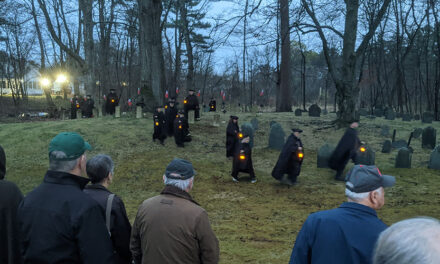Published in the December 21, 2016 edition
By GAIL LOWE
LYNNFIELD — You see them in the floral section of grocery stores and garden centers around this time of year. The amaryllis plant. The packaging is pretty enough. The bulbs come in a box about 6×6 inches with a picture of what the plant will look like when it finally blooms around Christmas time or a little later. The blooms range in color from bright red to soft pink.
Open the box, look inside and you’ll find a plastic green pot and what looks like a clump of dirt packaged in plastic. The amaryllis bulb is secreted away inside the dirt.
I first learned about amaryllis plants when I was a young mother heavily involved in my daughter Beth-Ann’s life, including extracurricular activities like Girl Scouts. Allison, her leader, was my friend.
Allison and I grew close because our daughters also were friends. On warm, sunny days we would spend hours on my back porch while we watched our children play. Life was good. But it was about to take a turn.
One early fall afternoon while we were sitting on the porch, Allison told me she had felt a lump in her left breast. She was planning to see her doctor in a few days and was worried because in her early 20s she had been diagnosed with Hodgkins lymphoma. She had beat that, but now she thought she might be facing something entirely new and even more dangerous. She had good reason to worry. When tests came back, the prognosis wasn’t good. Over the following year, her disease spread, including to her bones, causing fractures and other complications.
One day in mid-December she called and asked me to visit. She had something she wanted to give me. That afternoon, I walked the few streets to her home and knocked on her door. It took Allison a few minutes to open it and when she did I saw that she had lost a significant amount of weight. She invited me in but cautioned that I should not give her a hug. Her bones had become so brittle they could snap like a twig, even from a light hug. I nodded and handed her a beautiful poinsettia plant. We went to her living room, and she pointed to her Christmas tree. “Under there, on the right. The package in red. It’s for you,” she said. I picked it up and sat across from her.
“This gift has meaning, as you will come to see.”
When I opened my gift, she explained. “It’s an amaryllis plant. Follow the directions on the box. Then put it in your front window, water it when it looks thirsty and watch for a miracle.”
After our visit, I walked home with a heavy heart. I knew that Allison didn’t have long to live and I would miss her terribly. I hoped only that her suffering would not be great.
When my daughter came home from school, she asked about the plant. “Allison gave it to me,” I said. “Let’s take it out of the box and get it started.” So we embarked on our little mother-daughter project.
I wondered how the the dirt-encrusted bulb could turn into something beautiful. The picture on the box showed a long stock with several magnificent red blooms. I didn’t hold out much hope. How could something so pretty grow out of that clump of dirt?
The days passed, one after the other, and every few days I would call Allison to see how she was feeling. “I’m holding up,” she would say. “I’ll be better soon.”
But her husband told another story. “It won’t be long,” he said. “If she makes it to Christmas, I’ll be surprised.”
When I heard the news, I sat crying in my living room, staring at the amaryllis plant and wondering about life. What was it all about, anyway? Why did some people live long lives while other people’s lives were cut off in their prime? I rose from my chair and moved toward the plant. When I looked down from where I was standing and saw nothing but dirt, I doubted that it would ever grow into something as beautiful as what was shown on the box.
Christmas that year came and went, just as it did in other years. Every few days I’d call to check on Allison, but now it wasn’t Allison I was talking to. It was either a visiting nurse or her husband. The news was always the same. “She’s hanging on.”
Daily, I would check the amaryllis plant to see how it was doing but I saw no signs of life. I had followed the directions perfectly, yet the plant stubbornly refused to give me a bloom. In mid-January, I called Allison’s home to see if I could visit. “Just for a few minutes,” her husband told me. “She doesn’t have long.”
Though the news was grim, I did my best to keep a cheery attitude. When Allison asked me how the plant was doing. I could see for myself that she was failing. Her breathing was labored and her skin had taken on a gray cast.
“It’s coming along,” I said, not wanting to disappoint her.
“Good. I knew it would.”
Three days after my visit, Allison died. I went to her wake and funeral to comfort her husband and children. In the days to follow, I delivered meals and prayed with the family. But nothing was going to bring their wife, mother and my friend back. We had all lost a wonderful woman.
A few weeks later, I was home alone and went to the living room window. A storm was raging outside, and snow was piling up at a rate of an inch every hour. And there sat the amaryllis, as brown and dismal as ever. Then, for some reason, I stuck my finger in the dirt covering the bulb. And that’s when I felt something. I moved the dirt around a bit and, to my surprise, I saw two tiny bright green shoots trying to push through the dirt. Though I was grieving the loss of Allison, the sight of those sprouts renewed my hope that she was still with me. Where there seemed to be nothing but death there was, after all, life. A resurrection, if you will.
As the days passed, the sprouts grew into two-foot-long stalks, and I could see that the plant would give me two blooms. They opened fully in early February, the month of love.
Now, many years later, I sometimes give amaryllis plants as gifts and tell the recipients to expect a miracle. I tell them the story of Allison and that if something looks like nothing more than a clump of dirt a miracle might be waiting to happen. If we’re patient, something beautiful might be waiting to emerge, something that is about to spring to life.
And that’s the long and short of the amaryllis plant — a diamond in the rough.




